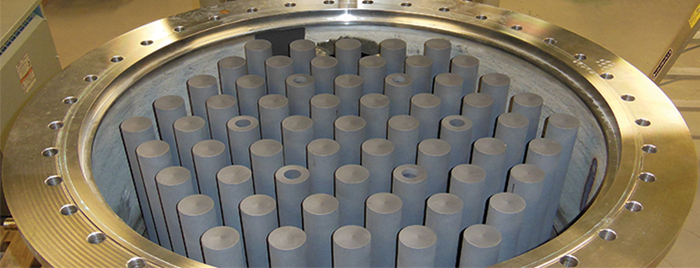Compared to its centuries-old fossil fuel counterparts, nuclear power is a young player in today’s lineup of energy sources. Still, since the world’s first nuclear power plant became operational in 1954, there have been three marked advancement periods, or generations, of nuclear technology. Each new generation has improved upon the current safety and performance of the previous generation. With the fourth on the horizon, nuclear scientists and engineers are designing a new suite of innovative technology systems that focus on safety and efficiency, which they estimate to be operational within the next 15 years. Xiaodong Sun, associate professor of the Nuclear Engineering Program in the Department of Mechanical and Aerospace Engineering at The Ohio State University, is ensuring that one of these new systems is as safe as possible, using high performance computing (HPC) resources to test prototypes.
One of the most promising Generation IV power plant designs is the Very High Temperature Reactor, due to its high efficiency electrical generation and hydrogen production provided by high operating temperatures. Though it is touted as one of the safest nuclear reactor designs in existence, one variable could compromise this: air ingress. Sun’s work focuses on the impacts of air leaking into the reactor pressure vessel where the VHTR reactor core is located to determine if the potential issue can be mitigated and, if so, by what means.
“Computer models have been developed to analyze this type of accident scenario,” Sun said. “There are, however, limited experimental data available to understand the phenomenology of the air-ingress accident and to validate these models.”
To test the air-ingress phenomenon, Sun and his team, Emeritus Professor Richard Christensen, Ph.D. candidate David Arcilesi, and Dr. Tae Kyu Ham, have constructed a one-eighth-scale test model of part of a VHTR reactor system. Since it would be physically difficult and time-consuming to test all possible accident scenarios in real time, Sun is using ANSYS FLUENT, a computational fluid dynamics software tool, to model and simulate the air-ingress phenomenon through Ohio Supercomputer Center resources. The simulations will vary based on the temperature and pressure of the helium in the VHTR pressure vessel and the location and size of the rupture. The one-eight-scale model facility will duplicate these FLUENT runs and the data obtained will validate the computational calculations.
Nuclear policy experts expect Generation IV reactors to rely more heavily on the natural laws of physics rather than people or machines for safety. Many nuclear designers favor the helium-cooled, graphite-moderated VHTR design because of its inherent safety characteristics: helium is completely inert and remains a gas at all operational and anticipated accident temperatures of the reactor, while the graphite core maintains structural stability at high temperatures. Though inherently safe, nuclear designers must consider worst-case scenario situations, such as a loss-of-coolant accident, or LOCA, in which helium escapes the reactor pressure vessel due to a rupture. During a LOCA, an air-helium mixture may enter the reactor pressure vessel due to one of two theorized ingress mechanisms: molecular diffusion or density-driven counter-current flow. Since oxygen chemically reacts with graphite, air ingress could lead to damage of the core-bottom graphite supporting structure and graphite in the reactor core, as well as the release of carbon monoxide and dioxide. Previous studies have shown that the graphite structure could lose up to 25 percent of its strength and 4.5 percent of its density due to an air-ingress event.
So far, Sun’s team has found the scaled-down model of part of the nuclear reactor would provide reliable data, closely resembling the air-ingress accident event that might occur in a full-sized prototype VHTR. They are currently testing the two different modes of air ingress to determine under which conditions each could dominate. This information will be used to improve VHTR prototype designs and accident mitigation. Generation IV designs aim to maintain today’s high level of safety while shifting from the current principle of mastering accidents, ensuring that the population is not affected when accidents occur, to the principle of excluding accidents entirely.
Project Lead: Xiaodong Sun, Ph.D., The Ohio State University
Research Title: Computational analysis of air-ingress phenomenon in very high-temperature gas-cooled reactors
Funding Source: The Ohio State University
Website: mae.osu.edu/people/sun.200

